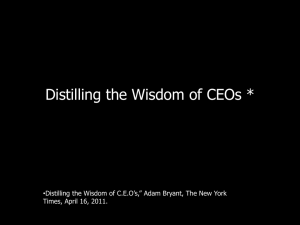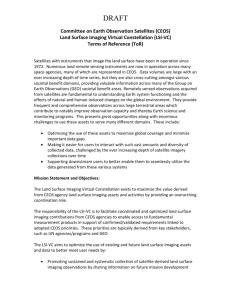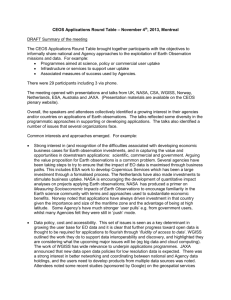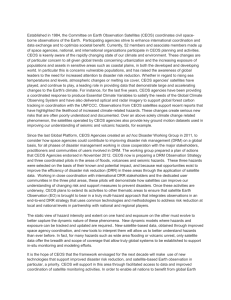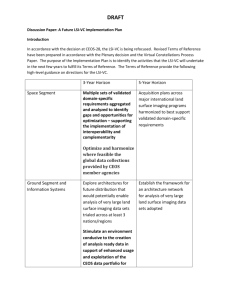Terms of Reference
advertisement
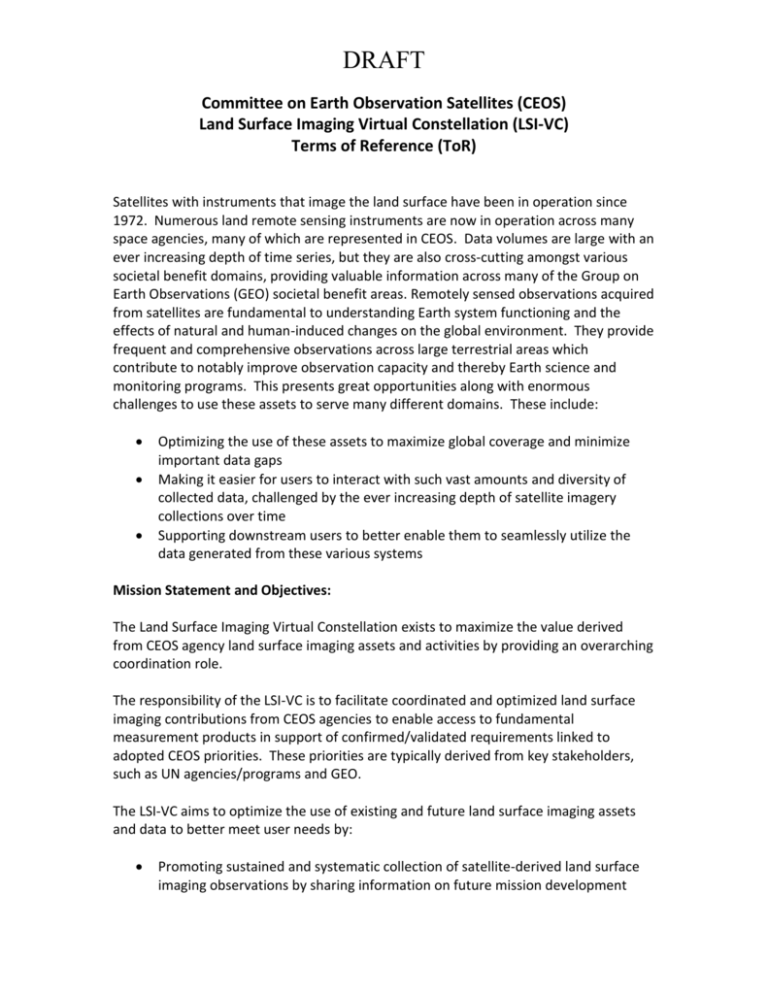
DRAFT Committee on Earth Observation Satellites (CEOS) Land Surface Imaging Virtual Constellation (LSI-VC) Terms of Reference (ToR) Satellites with instruments that image the land surface have been in operation since 1972. Numerous land remote sensing instruments are now in operation across many space agencies, many of which are represented in CEOS. Data volumes are large with an ever increasing depth of time series, but they are also cross-cutting amongst various societal benefit domains, providing valuable information across many of the Group on Earth Observations (GEO) societal benefit areas. Remotely sensed observations acquired from satellites are fundamental to understanding Earth system functioning and the effects of natural and human-induced changes on the global environment. They provide frequent and comprehensive observations across large terrestrial areas which contribute to notably improve observation capacity and thereby Earth science and monitoring programs. This presents great opportunities along with enormous challenges to use these assets to serve many different domains. These include: Optimizing the use of these assets to maximize global coverage and minimize important data gaps Making it easier for users to interact with such vast amounts and diversity of collected data, challenged by the ever increasing depth of satellite imagery collections over time Supporting downstream users to better enable them to seamlessly utilize the data generated from these various systems Mission Statement and Objectives: The Land Surface Imaging Virtual Constellation exists to maximize the value derived from CEOS agency land surface imaging assets and activities by providing an overarching coordination role. The responsibility of the LSI-VC is to facilitate coordinated and optimized land surface imaging contributions from CEOS agencies to enable access to fundamental measurement products in support of confirmed/validated requirements linked to adopted CEOS priorities. These priorities are typically derived from key stakeholders, such as UN agencies/programs and GEO. The LSI-VC aims to optimize the use of existing and future land surface imaging assets and data to better meet user needs by: Promoting sustained and systematic collection of satellite-derived land surface imaging observations by sharing information on future mission development DRAFT Drawing together validated requirements identified by downstream user communities to: o Identify opportunities to better optimize, and increase resilience of, land surface imaging programs o Identify current and potential data gaps (both in terms of geographic and temporal coverage, and in land monitoring requirements) Coordinating production and distribution of, and ability to analyze, fundamental, non-domain specific, measurements derived from land surface imaging observations (e.g. surface reflectance, land surface temperature, calibrated radar backscatter [gamma and sigma nought]) Facilitating maximum utilization of land surface imaging observations through the promotion of common standards making land surface image products more easily discovered and ready for analysis Characterization of the space segment and measurements concerned: All CEOS Agency space-based remote sensing instruments that generate data that can characterize the land surface and the organic and inorganic material on it are deemed to be in scope. This includes space-based remote sensing instruments operating in the visible, infrared, and microwave portions of the electromagnetic spectrum. Activities, Outcomes and Deliverables The scope of LSI-VC activity includes: Assessing land surface imaging data requirements, identifying the fundamental measurements that are required from land surface imaging assets to meet them, and undertaking gap analyses Facilitating the coordination of mission development to ensure the overall set of space assets is optimized, within the supplying organizations’ abilities and constraints, to support the overall package of validated data requirements Harmonizing, based on inputs received from CEOS Working Groups and ad hoc teams, periodic acquisition planning to optimize asset use and help facilitate the resolution of conflicts between competing requirements, while promoting resiliency and redundancy – reconciliate the various sets of requirements by providing an overarching discussion forum among the various land surface domains Support the coordination of the retrieval and reprocessing of historical products DRAFT to fill gaps in archives where required to support validated time series analysis requirements Support the coordination (along with the CEOS Working Group on Calibration and Validation (WGCV)) the implementation of consistent calibration and preprocessing approaches so that observation data are used to produce comparable fundamental measurement products for user benefit Facilitate the coordination of the implementation of CEOS land surface imaging data processing, distribution and analysis capabilities (such as those being developed by the CEOS Systems Engineering Office (SEO) and the Working Group on Information Systems and Services (WGISS)), which enable the broadest user access to fundamental measurement products for generating derived products Space Segment Ground Segment and Information Systems 3-Year Horizon Multiple sets of validated domain-specific requirements aggregated and analyzed to identify gaps and opportunities for optimization – supporting the implementation of interoperability and complementarity Optimize and harmonize where feasible the global data collections provided by CEOS member agencies Explore architectures for future distribution that would potentially enable analysis of very large land surface imaging data sets trialed across at least 3 nations/regions Stimulate an environment conducive to the creation of analysis ready data in support of enhanced usage 5-Year Horizon Acquisition plans across major international land surface imaging programs harmonized to best support validated domainspecific requirements Establish the framework for an architecture network for analysis of very large land surface imaging data sets adopted DRAFT and exploitation of the CEOS data portfolio for land surface imaging Products and Services 1-2 compatible nondomain specific measurement products, derived from 1 sensor, being produced by multiple Agency systems 4-5 compatible nondomain specific measurement products, derived from 3-4 sensors, being produced by multiple Agency systems Implementation and coordination issues to be addressed: The following table outlines key linkages between the LSI-VC and CEOS Entities and CEOS Stakeholders. These linkages must be successfully established and maintained if the LSI-VC is to achieve its objectives. Linkage Role of LSI-VC Role of identified CEOS Entity Identify CEOS priorities and identify valid sets of requirements towards which land surface imaging assets should be optimized. Domain-focused CEOS Entities Explore opportunities to optimize the acquisition, production and distribution of fundamental measurement products to meet confirmed requirements. Identify conflicts and gaps between different requirement sets. Identify and confirm target derived products and observational requirements. WGISS Coordinate implementation and operation of ‘backbone’ data discovery, Define standards and developing technologies suitable for adoption to CEOS Plenary DRAFT distribution and access systems for land surface imaging data and fundamental measurement products derived therefrom. achieve this goal. Provide technical advice. SEO / ESA EO HandBook/MIM Team Identify and, where feasible, mitigate gaps in historical data, current acquisition plans, and future mission scenarios. Provide technical advice, systems (such as COVE) and authoritative data (such as the MIM database) to support gap analysis work. WGCV Coordinate the implementation of preprocessing systems to promote alignment with techniques and standards defined by WGCV. Develop the techniques and standards necessary to produce the required fundamental measurement products, to support quality assessment of data, and to enhance interoperability of data from different sensors. WGCapD Communicate CEOS LSI mission data that are (widely) available to all users, with special attention to most recent. Communicate architectural developments as they impact (positively) the end user community. Communicate details regarding the LSI-VC measurement products. Incorporate LSI-VC concepts and measurement product information (when available) into training materials. Provide information regarding processing, distribution and analysis challenges encountered. Meetings: The LSI-VC will primarily utilize e-mail exchanges, telecons or video conferencing sessions, and workshops as needed to fulfill its objectives. A bi-annual meeting will be convened by one of the Co-Leads which may coincide with other CEOS meetings where common members can be expected to be in attendance. Membership and leadership: LSI-VC participation is open to all CEOS Agencies, and organizations they sponsor, that are willing to support and contribute to activities that are in scope for LSI-VC DRAFT The LSI-VC is a CEOS working body and representatives should possess relevant qualifications in satellite data acquisition planning, and/or requirements analysis, and/or data pre-processing and distribution for their agency missions. The following CEOS Agencies are actively involved in LSI-VC as at adoption of these Terms of Reference: Canadian Space Agency European Commission European Space Agency Geoscience Australia Japan Aerospace Exploration Agency National Aeronautics and Space Administration United States Geological Survey
